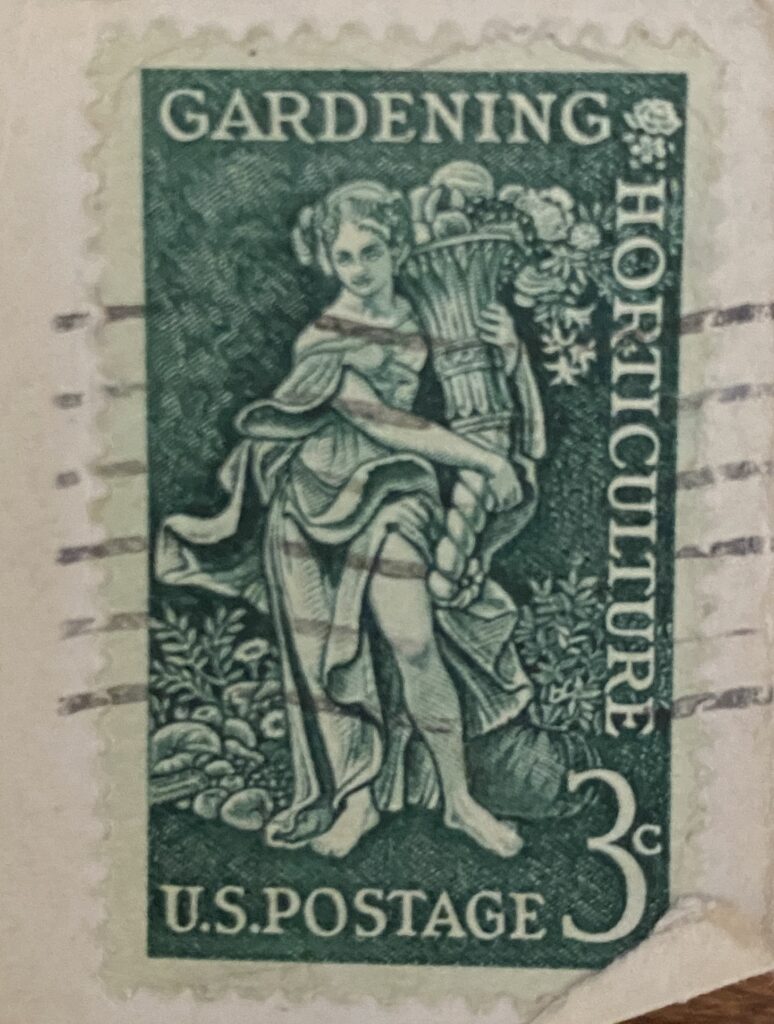
I received an unexpected card in the mail yesterday, with a little note and an old 3 cent gardening stamp enclosed. The sender found the stamp in her father’s papers and immediately thought, “Carol would like this.” And sent it to me.
(It isn’t that unusual for people to run across old gardening related items and think I might like them. They usually aren’t wrong.)
Getting that note amidst the junk mail and political flyers was quite nice!
You know what happened next?
That stamp sent me tumbling down a philately rabbit hole like a rabid philatelist. Philately is what they call stamp collecting and philatelists are stamp collectors
Down in that philately rabbit hole, I discovered that this stamp was issued in March 15, 1958 to commerate the 100th anniversary of the birth of the great horticulturist Liberty Hyde Bailey.
I also found out that you can still buy this particular stamp in an unused state from sellers on eBay, Etsy, and the like, but rather than paying 3 cents for it, it will cost you a couple dollars per stamp. If you want to pay that, the post office will still accept it as valid postage but, sadly, today, you’ll need 21 of them to send a first-class letter weighing less than one ounce.
Compare that to the price of mailing out a letter in 1958, which was 3 cents, and had been since 1933. That’s 25 years without a price increase! Then in 1959, they raised the price up by one cent to 4 cents. So in the course of my lifetime, postage has gone up 59 cents to what it is currently. I digress…
My next rabbit hole dive was to find out if the image on this gardening stamp came from a statue of some kind that already existed or did they make it up for the stamp.
Deeper, deeper, deeper I went down the philately rabbit hole. I tried not to look around for other gardening-related stamps.
(Would the study and collecting of gardening related stamps be called hortiphilately? My searches for that word came up empty. New word alert! Dibs on hortiphilately, which is the only philately I’m interested in! Definition: The collection and study of stamps related to gardening and horticulture. A hortiphilatelist studies gardening related stamps. In a sentence…”With her love of all things gardening, it was no surprise that Carol took up the hobby of hortiphilately when she got that gardening stamp and wondered if there were other hortiphilatelists like her?”)
In the March 10, 1958 edition of The Ithaca Journal, I read that the stamp was designed by the artist Denver Gillen (1914-1975). And I quote…
“The stamp carries a figure emblematic of the bountiful earth, holding forth a horn of plenty, and surrounded by flowers, fruits, vegetables, and shrubs. A rose and columbine appear in the upper right corner of the stamp, which is printed in green.” (The article I pulled that quote from misspelled columbine as “colubine.”)
I found nothing in my searches for a sculpture that looked the lady on the stamp, so I think the artist made her up on his own.
They originally printed 120 million of these stamps and shipped 1.5 million of them to the Ithaca post office for first day issues. Why Ithaca? It’s the home of Cornell University where Mr. Bailey studied horticulture.
Why didn’t they feature Liberty Hyde Bailey on the stamp since it was issued in his honor? That was an easy answer to find. The post office had a rule at the time that you had to be deceased for at least 25 years before your image could be put on a stamp. Mr. Bailey died in 1954.
And that was my deep, and brief, dive down into the rabbit hole of philately, the collection and study of stamps.
Anyway, it was lovely to get the card and the stamp. I shall post it forward, so to speak, and look for opportunities to send unexpected cards with some little treasure inside whenever I can. Who knows what rabbit hole it might send someone down?


Veryinteredting
Well, I’m happy that this minor act triggered this blog story and history research! Cheers!
Thanks for sending it to me!